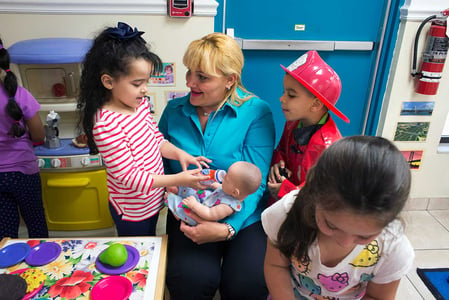
Years ago I was visiting with a really wonderful teacher at a Head Start preschool classroom in Miami. As I was leaving, she said to me, “I’m getting these kids ready for the FCAT!” (The FCAT—Florida’s Comprehensive Assessment Test—is a high stakes test that’s administered starting in third grade.) I was so struck by that comment and what it said about how she viewed her job that it has stayed with me all these years.
How do effective teachers balance the developmental needs of preschoolers with the pressure to get children ready for school? The intersection between children’s emerging capabilities and our goals and expectations for them can be a tough place to operate. This is one of the reasons we do observation training and professional development geared to specific age levels: the needs of children and teachers at each level are so unique.
Children aged three to five are developing rapidly:
-
They are getting more independent.
-
They are beginning to understand the thoughts and intentions of others, and use that understanding to engage in more complex, creative play with peers.
-
They can describe the world around them, compare and contrast, make predictions.
-
They are beginning to label their emotions, control their behavior, and persist with challenging tasks.
-
They are starting to attach meaning to symbols, which paves the way for early literacy and math skills.
They can also be impulsive, headstrong, distractible, inattentive, and silly—all developmentally appropriate!—but it falls to teachers to decide, for example, what is following a child’s lead and what is just plain getting off track.
We have expectations for what school readiness is—for example, that a child can follow simple directions, pay attention long enough to learn, get along with other children, recognize the letters of the alphabet, and count to ten. But effective teaching in preschool is more about the hows than the whats.
-
How do you get children to pay attention? By choosing developmentally-appropriate activities and using active facilitation.
-
How do you promote social skills? By providing a well-ordered, low-chaos environment with scaffolding and positive adult modeling when needed.
-
How do you teach early literacy? By providing a language rich environment, getting children to engage deeply with books, play with new words, and have lots of conversations.
-
How do you handle an outbreak of silliness? Sometimes you just have to go with the flow and switch out your book reading with a music and movement activity.
Attending to the hows over the whats can be the difference between playing a rhyming game versus using phonemic awareness flashcards. It’s those hows that we capture when we observe using the Pre-K CLASS tool, and what we focus on when we work with preschool teachers.
For more, check out our research summary on Teacher-Child Interactions in Early Childhood.

